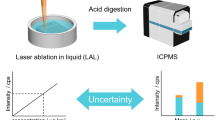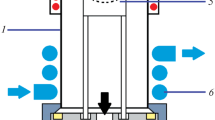Abstract
High resolution inductively coupled plasma mass spectrometry (HR-ICP-MS) was applied for multielement-determination in high-purity copper (approx. 99.99%). The samples were introduced into the instrument by three different introduction systems, which were studied with respect to high accuracy, low detection limits and fast analysis: continuous nebulization (CN), flow injection analysis (FIA) and laser ablation (LA). The trueness of the applied method was checked by the analysis of high-purity copper reference material (BCR Cu074). All values obtained for this CRM using CN were in the range of the stated uncertainty for the 9 elements determined: Ag, As, Bi, Cr, Fe, Ni, Pb, Sb, and Sn with contents in the range of 0.5–13 μg/g. Another approach for checking the trueness of the method was to compare the results obtained by this method characterizing the purity of a 4N (99.99% copper content) copper material with those obtained by application of electrothermal atomic absorption spectrometry (ET-AAS) and inductively coupled plasma optical emission spectrometry (ICP-OES). For further characterizing, the concentrations of 49 elements were found in this material below detection limits of HR-ICP-MS in the range of low μg/kg and sub μg/kg. The combination of HR-ICP-MS and a flow injection analysis system (FIAS) improved the robustness of the system in regard to high matrix concentrations. Therefore, matrix concentrations up to 4 g/L could be used for liquid analysis and detection limits were lowered by a factor of 2–5. A calibration method for bulk analysis with laser ablation was developed with doped copper powder as pressed pellets for calibration standards. This method proved to be an excellent fast semi-quantitative method, which was less time consuming in comparison with the analysis of liquids. After application of correction factors the deviation between the results obtained by laser ablation and by analysis of liquids was ≈ 15% for most elements. The method offered the possibility to check for potential losses of analytes occurring during the wet chemical operations.
Similar content being viewed by others
Author information
Authors and Affiliations
Additional information
Received: 23 November 1998 / Revised: 25 February 1999 / Accepted: 2 March 1999
Rights and permissions
About this article
Cite this article
Pattberg, S., Matschat, R. Determination of trace impurities in high purity copper using sector-field ICP-MS: continuous nebulization, flow injection analysis and laser ablation. Fresenius J Anal Chem 364, 410–416 (1999). https://doi.org/10.1007/s002160051358
Issue Date:
DOI: https://doi.org/10.1007/s002160051358




